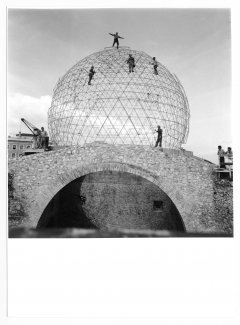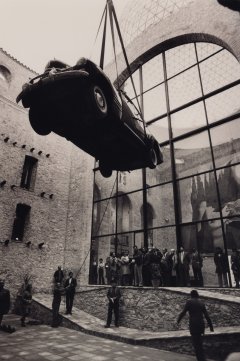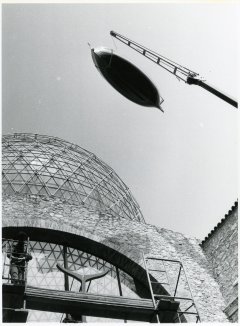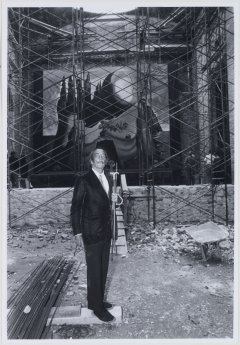The world's largest surrealist object
Inaugurated in 1974, the Dalí Theatre-Museum rises on the remains of the former Municipal Theatre of Figueres and is considered to be the last great work of Salvador Dalí. Everything in it was conceived and designed by the artist so as to offer visitors a real experience and draw them into his unique and captivating world.
The Dalí Theatre-Museum's collection allows the visitors to capture the artistic journey of Salvador Dalí (1904-1989) through a broadspectrum of works. The route around the rooms allows visitors to capture his first artistic experiences, surrealism, nuclear mysticism and his passion for science, guiding them tothe works of the last part of his life.
A visit to the museum is a unique experience, allowing visitors to experience and enjoy the genius's works and thoughts. In the words of Dalí himself: "It's obvious that other worlds exist, that's certain; but, as I've already said in many other occasions, these other worlds are inside ours, they reside on earth and are precisely at the centre of the dome of the Dalí Museum, which contains the new, unsuspected and hallucinatory world of Surrealism".
Origins and creation
The embryo of the Theatre-Museum project started at the beginning of the 'sixties. Ramon Guardiola, mayor of Figueres at the time, asked Salvador Dalí to donate a work for the Museu de l'Empordà. Dalí's reply came quickly: he would donate to Figueres not just a single work, but an entire museum:
"Where, if not in my own town, should the most extravagant and solid of my work endure, where if not here? The Municipal Theatre, or what remained of it, struck me as very appropriate, and for three reasons: first, because I am an eminently theatrical painter; second, because the theatre stands right opposite the church where I was baptised; and third, because it was precisely in the hall of the vestibule of the theatre where I hosted my first exhibition."
The place in which the Dalinian project was to be located, as a specific wish of the artist, was the former Municipal Theatre of Figueres. Destroyed in a fire at the end of the Spanish Civil War, the building had been reduced to its peripheral structure. The ceiling of the orchestra pit had collapsed; of the boxes there remained only the access corridors to them and to the stage, the arch of the stage mouth and the side stores; the entrance hall and the rest room were the only parts that remained more or less intact. The artist planned to take advantage of the spectral charm offered by the ruins of the former theatre in order to house the future museum.
From the 'seventies onwards, Dalí devoted his entire attention to the museum project, taking part in it and designing its tiniest details, until it became real with the official inauguration of the Dalí Theatre-Museum on 28 September 1974. One of the most noticeable features of the museum, the transparent reticular-shape like a geodesic dome that crowns the building, was entrusted by Salvador Dalí to the Murcian architect Emilio Pérez Piñero (1935-1972). That dome has now become the emblem of the Theatre-Museum and a great icon for the city of Figueres.
The Museum today
The various collections of the Fundació Gala-Salvador Dalí include all types of works of art: paintings, drawings, sculptures, engravings, installations, holograms, stereoscopes, photography, etc. Of them, some 1,500 are on exhibition at the Dalí Theatre-Museum in Figueres.
The world's largest surrealist object
Inaugurated in 1974, the Dalí Theatre-Museum rises on the remains of the former Municipal Theatre of Figueres and is considered to be the last great work of Salvador Dalí. Everything in it was conceived and designed by the artist so as to offer visitors a real experience and draw them into his unique and captivating world.
The Dalí Theatre-Museum's collection allows the visitors to capture the artistic journey of Salvador Dalí (1904-1989) through a broad spectrum of works. Walking through the exhibition rooms allows visitors to capture Dalí's first artistic experiences, surrealism, nuclear mysticism and passion for science, and guide them to the works of the last part of his life.
Visiting this museum is a unique opportunity to experience and enjoy the work and thought of a genius. In the words of Dalí himself: "It's obvious that other worlds exist, that's certain; but, as I've already said in many other occasions, these other worlds are inside ours, they reside on earth and are precisely at the centre of the dome of the Dalí Museum, which contains the new, unsuspected and hallucinatory world of Surrealism".
Origins and creation
The embryo of the Theatre-Museum project started in the early sixties. Ramon Guardiola, mayor of Figueres at the time, asked Salvador Dalí to donate a work for the Museu de l'Empordà. Dalí's reply came quickly: not only would he donates an artwork to Figueres, but also an entire museum:
"Where, if not in my own town, should the most extravagant and solid of my work endure, where if not here? The Municipal Theatre, or what remained of it, struck me as very appropriate, and for three reasons: first, because I am an eminently theatrical painter; second, because the theatre stands right in front of the church where I was baptised; and third, because it was precisely in the entrance hall of the theatre that I hosted my first exhibition."
The place where the Dalinian project was to be located -upon specific wish of the artist- was therefore the former Municipal Theatre of Figueres. Destroyed in a fire at the end of the Spanish Civil War, the building was left to its peripheral structure. The ceiling of the orchestra pit had collapsed; of the boxes, only the access corridors remained, and of the stage, only the arch of the stage and the side stores; the entrance hall and the rest room were the only parts that remained more or less intact. The artist wanted to take advantage of the spectral charm offered by the ruins of the former theatre to house his future museum.
From the seventies onwards, Dalí devoted his entire attention to the museum project, taking a huge part in it and designing its every detail, until it became real with the official inauguration of the Dalí Theatre-Museum on 28 September 1974. One of the most noticeable features of the museum was the transparent reticular structure shaped like a geodesic dome that crowns the building. which was entrusted by Salvador Dalí to the Murcian architect Emilio Pérez Piñero (1935-1972). That dome has now become the emblem of the Theatre-Museum and a great landmark of the city of Figueres.
The Museum today
The various collections of the Gala-Salvador Dalí Foundation include all types of works of art: paintings, drawings, sculptures, engravings, installations, holograms, stereoscopes, photography, etc. Among them 1,500 works are exhibited at the Dalí Theatre-Museum of Figueres.
The Dalí Theatre-Museum consists of three clearly differentiated museum areas offering the visitors an unguided andpersonal route across the various galleries:
1) The Theatre-Museum as such, refurbished from the old fire-damaged municipal theatre, converted into the Theatre-Museum based on the criteria and design of Salvador Dalí himself. This part of the museum forms a unique artistic object in which each element is an inseparable part of the whole.
2) The group of galleries resulting from the progressive extensions of the Theatre-Museum, in which Dalí's personal intervention is superficial or non-existent. These galleries contain many works from the artist's legacy- stereoscopic works, installations, and anamorphisms-, as well as the Foundation's new acquisitions.
3) The Dalí·Jewels exhibition rooms, inaugurated in 2001, which contain the thirty-seven gold jewels and precious stones from the former Owen Cheatham collection, in addition to two jewels made later and the prior designs made by the painter.
The Dalí Theatre-Museum is home to a wide spectrum of works that recounts the artistic trajectory of the Empordà county artist, ranging from his first artistic experiences (impressionism, futurism, cubism, etc.) and his surrealist creations, to the last years of his life. Some of the most outstanding works on display are Self-Portrait with l'Humanité (1923), Port Alguer (1924), The Spectre of Sex-Appeal (1932), Portrait of Gala with Two Lamb Chops Balanced on Her Shoulder (1933), Soft self-portrait with grilled bacon (1941), Poetry of America / The Cosmic Athletes (1943), Galarina (1944-45), The Basket of Bread (1945), Leda Atomica (1949) and Galatea of the Spheres (1952), among many others.
We should also highlight the set of works the artist created expressly to be on permanent exhibition at the museum, works that range from paintings and sculptures to complex and monumental installations. Among them are the Mae West Room, the Wind Palace gallery, the Monument to Francesc Pujols and the Rainy Cadillac ( that you can see in our virtual visit).
Aside from Salvador Dalí's works, there are works by other artists that the painter invited to be exhibited in his museum, such as Antoni Pitxot and Evarist Vallès, accompanied by other artist from the painter's own private collection, such as El Greco, Marià Fortuny, Modest Urgell, Ernest Meissonier, Marcel Duchamp, Gerard Dou and Bouguereau. In various galleries of the Theatre-Museum we can also find works by John de Andrea, Wolf Vostell, Meifrén and Ernst Fuchs. Since Salvador Dalí death in 1989, the crypt where he is buried can also be visited at the centre of the museum. This area was remodeled in 1997 to exhibit a collection of gold jewels designed by the artist.









